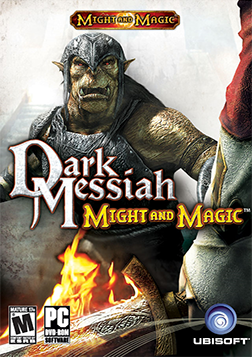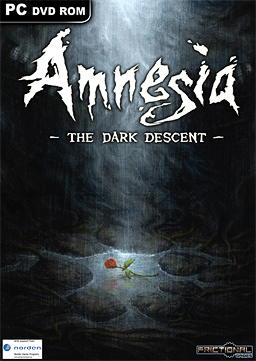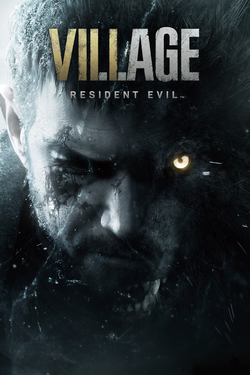Survival horror is a subgenre of horror games. Although combat can be part of the gameplay, the player is made to feel less in control than in typical action games through limited ammunition or weapons, health, speed, and vision, or through various obstructions of the player's interaction with the game mechanics. The player is also challenged to find items that unlock the path to new areas and solve puzzles to proceed in the game. Games make use of strong horror themes, such as dark mazelike environments and unexpected attacks from enemies.

Dark Messiah of Might and Magic is a first-person action role-playing game developed by Arkane Studios. The player controls Sareth, the apprentice of the wizard Phenrig, after he is sent to the city of Stonehelm to accompany an expedition trying to retrieve a powerful artifact known as "The Skull of Shadows".

Call of Cthulhu: Dark Corners of the Earth is a survival horror video game developed by British studio Headfirst Productions for the Xbox in 2005 and for Microsoft Windows in 2006. It combines an action-adventure game with a relatively realistic first-person shooter and elements of a stealth game.

Alone in the Dark is a 1992 survival horror video game designed by Frédérick Raynal. Developed and published by Infogrames in 1992 for MS-DOS, the game was eventually ported to MacOS, the PC-98, the FM Towns, the 3DO, the Acorn Archimedes, and iOS. Alone in the Dark is set in 1920s Louisiana and challenges the player to escape a haunted mansion. To advance, the player must solve puzzles while banishing, slaying, or eluding various ghosts and monsters. The player can collect and use weapons, manage a weight-based inventory system, and explore a partially nonlinear map.

Fallout: Brotherhood of Steel is an action role-playing game developed and published by Interplay Entertainment, and distributed in Europe by Avalon Interactive for the Xbox and PlayStation 2. Released on January 13, 2004, Fallout: Brotherhood of Steel was the fourth video game to be set in the Fallout universe. It was also the first to be made for consoles, and the last to be made during Interplay's initial run on the series, before the rights passed to Bethesda Softworks. The game chronicles the adventures of an initiate in the fictional Brotherhood of Steel, a militant quasi-religious organization that has come to power in a post-apocalyptic world.

Soma is a survival horror video game developed and published by Frictional Games. The game was released on 22 September 2015 for Microsoft Windows, OS X, Linux, and PlayStation 4, and on 1 December 2017 on Xbox One.

Baldur's Gate: Dark Alliance is a 2001 action role-playing video game developed by Snowblind Studios and published by Interplay Entertainment subsidiary Black Isle Studios for the PlayStation 2 and the Xbox consoles, with High Voltage Software handling the GameCube port, and Magic Pockets developing the Game Boy Advance version. CD Projekt was developing a version for Microsoft Windows, but was ultimately cancelled. In 2021, a 4K port of the game was released for the Xbox One, PlayStation 4, PlayStation 5, Xbox Series X/S, Nintendo Switch and PC.

Penumbra: Overture is the first in a series of episodic survival horror games developed by Frictional Games. The game follows a physicist named Philip who travels to Greenland after his mother's death and is forced to explore an abandoned mine. Penumbra: Overture received average reception from critics.

Frictional Games AB is a Swedish independent video game developer based in Malmö, founded in January 2007 by Thomas Grip and Jens Nilsson. The company specialises in the development of survival horror games with very little or no combat gameplay mechanics. It is best known for its games Amnesia: The Dark Descent and Soma.

Ghosts 'n Goblins, known in Japan as Makaimura, is a run-and-gun platform video game series created by Tokuro Fujiwara and developed by Capcom. The first entry in the series was Ghosts 'n Goblins, released in arcades on July 7, 1985. The series has subsequently been ported to and released on a variety of personal computers, game consoles and mobile platforms and spawned several sequels and spin-offs.

Amnesia: The Dark Descent is a 2010 survival horror adventure game developed and published by Frictional Games. It was released in 2010 for Microsoft Windows, Mac OS X and Linux operating systems, in 2016 for the PlayStation 4 platform and in 2018 for the Xbox One. The game features a protagonist named Daniel exploring a dark and foreboding castle called Brennenburg, while trying to maintain his sanity by avoiding monsters and unsettling events. The game was critically well-received, earning two awards from the Independent Games Festival and numerous positive reviews.

Amnesia: A Machine for Pigs is a 2013 survival horror game developed by The Chinese Room and published by Frictional Games. Originally meant to be a mod, the game is an indirect sequel to Amnesia: The Dark Descent (2010), which was both developed and published by Frictional Games. While set in the same universe as the previous game, it features a new cast of characters and time setting.

Magrunner: Dark Pulse is a puzzle game developed by Frogwares. It was released as a downloadable title on Microsoft Windows on 20 June 2013, PlayStation Network on 23 October 2013, and Xbox Live Arcade on 25 October 2013. Magrunner: Dark Pulse is set in a cyberpunk reimagining of H. P. Lovecraft's Cthulhu Mythos.

Rise of the Tomb Raider is a 2015 action-adventure game developed by Crystal Dynamics and published by Microsoft Studios and Square Enix. The game is the eleventh main entry in the Tomb Raider series, the sequel to the 2013's Tomb Raider, and is the second instalment in the Survivor trilogy. Its story follows Lara Croft as she ventures into Siberia in search of the legendary city of Kitezh while battling the paramilitary organization Trinity, which intends to uncover the city's promise of immortality. Lara must traverse the environment and combat enemies with firearms and stealth as she explores semi-open hubs. In these hubs she can raid challenge tombs to unlock new rewards, complete side missions, and scavenge for resources which can be used to craft useful materials.
A horror game is a video game genre centered on horror fiction and typically designed to scare the player. The term may also be used to describe tabletop games with horror fiction elements.

Resident Evil Village is a 2021 survival horror game developed and published by Capcom. It is the sequel to Resident Evil 7: Biohazard (2017) and the tenth main game of the Resident Evil series. Players control Ethan Winters, who searches for his kidnapped daughter in a village filled with mutant creatures. Village maintains survival horror elements from previous games, with players scavenging environments for items and managing resources while also adding more action-oriented gameplay, with higher enemy counts and a greater emphasis on combat.

Call of the Sea is an adventure video game developed by Out of the Blue and published by Raw Fury. The game was released for Windows, Xbox One, and Xbox Series X/S on December 8, 2020. The game was also released for Amazon Luna on April 15, 2021, and for PlayStation 4 and PlayStation 5 on May 11, 2021.

Maid of Sker is a 2020 first-person survival horror game developed and published by Wales Interactive. The game is set in 1898 in the Sker Hotel, on an imaginary island called Sker Island. The protagonist, Thomas Evans, is invited by his lover, Elisabeth Williams, to uncover the mysteries of the hotel after she notices her family's strange behavior. While exploring the hotel, Thomas learns cult followers called "The Quiet Ones" control the place. He finds notes and gramophone records scattered around the hotel that reveal the history of Elisabeth's family.

Alone in the Dark is a 2024 survival horror video game developed by Pieces Interactive and published by THQ Nordic. The game is a reimagining of the original 1992 Alone in the Dark and is the seventh installment in the Alone in the Dark video game series. The game features a single-player narrative set in the 1930s, where players can choose to play as Edward Carnby or Emily Hartwood, as they make their way through Derceto Mansion to uncover the mysteries within. It was released for PlayStation 5, Windows, and Xbox Series X/S on 20 March 2024. Upon release, it received mixed reviews from critics.

Amnesia: The Bunker is a survival horror video game developed and published by Frictional Games. The fourth installment in the Amnesia series, the game follows a French soldier who is trapped in a bunker with a monster and must find a way to escape. It was released for Windows, PlayStation 4, Xbox One and Xbox Series X/S on June 6, 2023. It received generally positive reviews from critics.



















